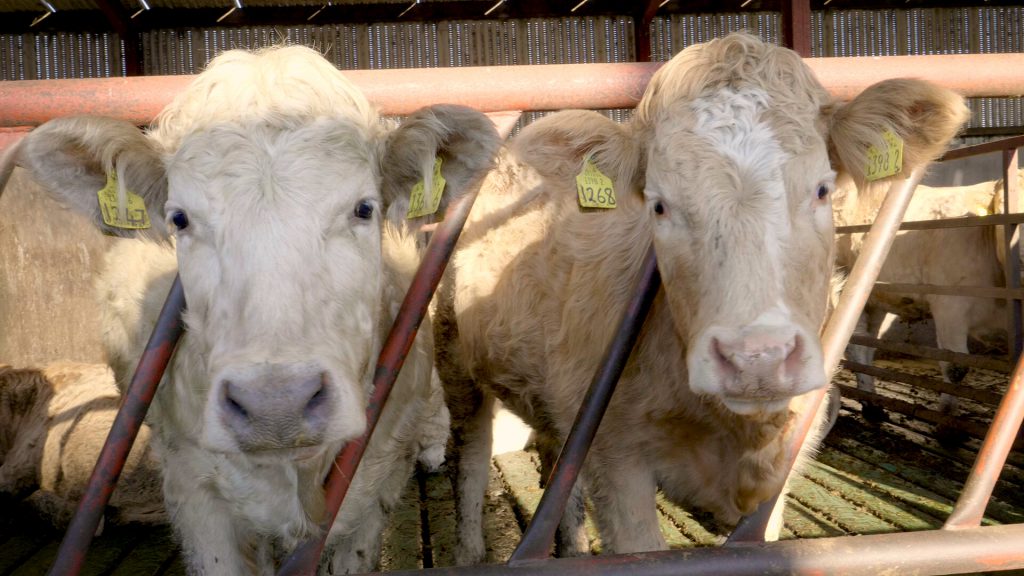The post Latest figures show demand for farmland ‘remains robust’ appeared first on Agriland.co.uk.
]]>Property consultancy Knight Frank’s latest farmland index Q3 has revealed that an acre of land is now worth £8,951 on average, showing that farmland demand “remains robust”.
The farm and estates team of the consultancy highlighted that the acre average price across England and Wales represents an 8% increase on the year.
According to the latest report, the firm predicts that, by the end of the year, average values may reach £9,000/ac, which could suggest the farmland market is either at or very close to its near-term peak.
Beyond that, 2024 is expected to bring in a period of consolidation as supply and demand finds stability, Knight Frank said.
Head of rural research at Knight Frank, Andrew Shirley, said: “Our latest Q3 figures show that demand for farmland remains robust, particularly among farmers who have sold land or faced compulsory purchase for housing and infrastructure projects like HS2, as they seek to reinvest their capital gains. In specific regions, this heightened demand has driven prices above £15,000/ac.
“However, environmental buyers, who have also been active in this market, are reportedly showing slightly less enthusiasm due to uncertainties surrounding the development of nature-based finance frameworks in the UK”.
Farmland values
Despite historically low levels of publicly advertised farmland, Knight Frank believes that there are a few indications of a “significant surge” in the coming year.
In Knight Frank’s annual flagship report, the Rural Report, the highest value of prime arable land that can be achieved sits across south west, south east, eastern and north east regions, where they can reach up to £12,536/ac.
Head of rural research at Knight Frank, Andrew Shirley, said: “Of the other asset classes Knight Frank tracks, only the FTSE 100 index, has significantly outperformed farmland in the past 12 months, boasting a remarkable 10% increase. Looking back over the last five years, farmland values have experienced a notable 27% growth, second only to gold, which saw an impressive 67% increase.
Head of farm and estates at Knight Frank, Will Matthews, said: “The land market continues to thrive with a minor uptick, showcasing its strength as we fight against inflation.
“There is a great deal of opportunity across the country, especially in the regional markets as premium land values continue soar to the top of the leader board.
“Currently, there is a lack of urgency to sell, resulting in a robust pricing for most of the stock, which is causing the gap between buyers and sellers to widen. However, despite this and increasing competition, quality stock is still in demand and selling well.”
The post Latest figures show demand for farmland ‘remains robust’ appeared first on Agriland.co.uk.
]]>The post Farmland remains ‘extremely resilient’ despite challenges – Strutt & Parker appeared first on Agriland.co.uk.
]]>Strutt & Parker has said farmland is remaining “extremely resilient” despite rising interest rates and a squeeze on farm profitability.
The property consultancy’s latest Farmland Database shows the average price of arable land sold so far during 2023 is £10,900.
This is lower than the £11,100/ac reported for HI 2023, but is the same as the 2022 average – which was 15% higher than 2021.
The Strutt & Parker database also revealed that, since 2000, arable farmland has outperformed the commercial and residential property sectors, and equities, delivering an annualised return of 7.8%
The value of arable farmland has risen by 29% over the past 10 years and by 351% over the past 20 years.
Head of estates and farm agency for Strutt & Parker, Matthew Sudlow, said: “Although it appears the growth in values has slowed in some locations, this is only because there have been fewer sales at £12,000/acre or more.
“Our analysis shows that 60% of the arable land traded in England this year has still sold for more than £10,000/acre, compared to 33% in 2021, highlighting the continued strength of the market.”
Demand for farmland
Sudlow said the feeling amongst agents is that demand is more variable for farmland than it was a year ago, but prime farms in popular areas of the country continue to sell well.
Buyers include farmers with rollover money to spend, private individuals, the investment sector and green investors.
“We’re also seeing some significant purchases from a handful of overseas buyers, who like the fact it is easier to buy at scale in the UK than in some other European countries,” he said.
“The UK’s appeal is being enhanced by our farming industry’s enthusiasm for adopting regenerative farming techniques.”
Traditional farmer buyers have accounted for around 40% of transactions so far in 2023. Historically, this figure tends to be 50-60%, Strutt & Parker said.
Supply rose in Q3 of this year, taking the total amount brought to the open market in England during the first nine months of the year to 65,600 acres, which is 9% above the five-year average.
There also continues to be “plenty of activity” on the private market, the consultancy said, but overall supply remains constrained in historical terms.
Positive outlook
Sudlow said the outlook for the coming year remains positive, although greater polarisation in values is a possibility.
“With demand becoming more variable, location is once again becoming an increasingly important factor in determining the price,” he said.
“The expectation is that the market is set to remain buoyant in the perennially popular areas of the country, such as the Cotswolds and counties close to London, and in other parts of the country where there are existing landowners looking to upsize.
“However, farms in traditionally less popular regions focused on productive farming may struggle to achieve the same level of interest as they would have seen last year.”
Levels of supply remain a talking point in the industry, Strutt & Parker said, with questions being asked about whether there could be a noticeable rise in the volume of land available, if farmers decide to sell up in the face of a difficult harvest, high input costs and falling Basic Payment receipts.
“While this is clearly a possibility, there is little hard evidence that it is happening yet,” Sudlow said.
Overall, the sentiment is that farmland remains a solid investment prospect, with a proven track record of capital growth, for a range of buyers, he said.
The post Farmland remains ‘extremely resilient’ despite challenges – Strutt & Parker appeared first on Agriland.co.uk.
]]>The post Farmland values set to reach £10,000/ac appeared first on Agriland.co.uk.
]]>Farmland is climbing in value with the average price of arable land in England forecast to reach £10,000/ac by the end of the year.
Analysis of Strutt & Parker’s farmland database, which records the details of all farms, estates and blocks of publicly marketed farmland in England over 100ac, shows that more than 50% of arable land sold so far in 2022 has sold for more than £10,000/ac – the first time this has happened.
This compares to just over 30% in 2021.
The proportion of land selling for more than £12,000/ac has also risen.
Tight supplies, coupled with strong demand, have pushed the average price of arable land sold during the first nine months of the year up 4% to £9,800/ac.
Land is also going under offer at the fastest rate for at least five years.
The average price of pasture has risen by 6% over the same period, to a record-breaking £8,000/ac.
“Our expectation is that by the end of 2022 the percentage increase for arable land could be about 6% too,” said Matthew Sudlow, head of estates & farm sgency for Strutt & Parker.
“There is currently a large amount of arable land under offer at prices which – once the sales have completed and the sold prices added to our dataset – are likely to push the average arable value to over £10,000/ac.
“The last time we saw average prices at this level was when the market peaked in 2014/2015.”
Supply has been growing, with 66,200ac publicly marked by the end of Q3, which is more than was marketed during the whole of 2021 or 2020.
However, most of this rise can be attributed to a small number of significant sales in terms of acreage – a number in the East of England – rather than a rise in the number of farms and estates being marketed.
Although the volume of land has increased compared to the past couple of years, supply remains at historically low levels and demand continues to outstrip supply.
The post Farmland values set to reach £10,000/ac appeared first on Agriland.co.uk.
]]>The post Research: Saliva sampling may help pig farmers target treatments appeared first on Agriland.co.uk.
]]>The study which is being carried out by researchers at Teagasc, the University of Murcia and the University of Lyon, is focused on how piglet’s rapidly learn to become independent from the sow in the early stages of life. However, it is doing this through a non-invasive approach to avoid inducing distress in the animals.
This is key, as handling a piglet for even one minute for blood sampling can cause so much stress that the carbon dioxide (CO2) levels in its blood reaches levels that would kill a human, Edgar Garcia Manzanilla, head of Teagasc’s pig development department said.
The collection of saliva samples is hugely beneficial said Manzanilla, not only is it a non-invasive method of collecting information, but the substance itself can tell researchers a huge amount. He told Agriland:
“Pigs are by nature very curious, they sample everything in their environment, so saliva contains a lot of information.
“We take advantage of that, we have a sponge, we give to them and they chew it, then you have a perfect sample, you just take a glove and squeeze it out.”
Information such as how the environment affects the microbiome of a pig, their intestinal health and their immunity can be gained from these samples, explained Manzanilla, who added that the long-term aim is to get pig farmers doing this type of testing themselves.
“Normally, you would have to call a vet to come on to your farm, collect the blood from the animal and then do the analysis somewhere else. What we are aiming for here is to give these samples to the farmers and they can do it any time they want.
“There is a bunch of pigs going through the farm every week, so they could each week, take one of the sponges, put some of the saliva in a kit that we give them and then they test how well or ill those animals are.”
The analysis of these samples could help farmers to catch illness in their herds earlier than is typically possible and ultimately reduce anti-microbial resistance by targeting treatments more effectively.
“When you are decreasing those treatments or preventing the resistance, it results in an animal that grows better, better quality of life for the animal and you are safeguarding the public health to some extent,” said Manzanilla.
He pointed out that the benefits of using this kind of testing on commercial pig farms will likely transfer into humans, as these animals ultimately end up in the food chain.
“So, it is of benefit beyond the animal itself, the environment is better, the animal is better and the people are better too,” he concluded.
You can watch the interview in full by clicking here.
The post Research: Saliva sampling may help pig farmers target treatments appeared first on Agriland.co.uk.
]]>The post Farmland demand continues to outstrip supply appeared first on Agriland.co.uk.
]]>Farmland and estates are being snapped up by buyers more quickly than for several years as demand continues to outstrip supply according to Strutt & Parker.
Analysis of Strutt & Parker’s Farmland Database, which records the details of all farms, estates and blocks of publicly marketed farmland over 100ac, shows that nearly half of the farms marketed this year are already either under offer or have exchanged.
This is a much greater proportion than was seen at the equivalent point in each of the past five years.
Tight supply and strong demand have pushed the average value of arable land in England up by 2% to £9,600/ac – the highest it has been since 2015. The average value of pasture land has also risen by 6% to £7,900/ac.
“We haven’t seen a farmland market like this for some time,” said Matthew Sudlow, head of estates & farm agency for Strutt & Parker.
“Competitive bidding and best-and-final offers are becoming common for top-quality properties in desirable locations.
“For example, a 500ac farm on the market recently for £7.25m attracted viewings from 17 interested parties and went under offer, after just five weeks, for more than its guide price, following a call for best-and-final offers.”
Supply is growing, with 43,400 ac publicly marketed in the first half of 2022, which is 12% more than in 2021 and 11% up on the five-year average.
However, most of this rise can be attributed to a small number of significant sales in the Eastern counties, rather than a rise in the number of farms being marketed.
There are more farms than usual available in northern England, although the majority of farms for sale are in southern England where there are slightly less available than on average.
The total number of farms publicly available so far this year – 121 – is only the same as the five-year average.
“Even if we consider the number of farms available privately, the volume of land available is, in most locations, still not high enough to meet demand,” said Sudlow.
“Demand remains robust because of the broad spectrum of buyer types wanting their own slice of the countryside – from farmers with rollover money, to lifestyle buyers and green investors looking to invest in natural capital.”
The post Farmland demand continues to outstrip supply appeared first on Agriland.co.uk.
]]>The post Watch: Farmland – machinery prices and farm costs appeared first on Agriland.co.uk.
]]>The latest episode of Farmland, which shines a light on how the current inflation and input crises are affecting two key areas within the agricultural industry – the machinery sector and farming families - is now available to watch.
In this latest programme, executive director of the Farm Tractor Machinery Trade Association (FTMTA) Michael Farrelly, talks to Agriland editor Stella Meehan about the impact of world events on machinery prices.
He presents his expectations for the industry, explaining that while sales remain strong currently, price rises are unavoidable as the manufacturing process of these products is energy intensive.
Despite a rise in prices, strong sales may continue according to Farrelly, following an increase in some commodity prices such as milk.
Farmland discusses silage
Also on the latest episode, Agriland journalist Richard Halleron presents his outlook on silage production in 2022.
He suggests that Ireland could face a fodder crisis in the back end of the year because of a shortage of silage as a result of farmers holding back on using fertiliser now.
Also on the programme, Alice Doyle, the Irish Farmers’ Association (IFA) chair of the Family Farm and Social Affairs Committee, speaks about the extra costs that farmers and their families are now experiencing.
She highlights rural disadvantage and the knock-on effects such as poor mental well-being and farm safety issues, as well as less income coming in through the farmgate and front door.

Doyle also discusses what she sees as a lack of consistency between Irish and EU policies governing the agri sector.
All episodes of Farmland can be streamed via the award-winning digital platform, agriland.ie by clicking here. Links will also be available across all Agriland social media channels.
Farmland Extra – the podcast, is also available on all major podcast platforms.
The post Watch: Farmland – machinery prices and farm costs appeared first on Agriland.co.uk.
]]>The post 31% increase in Scottish farmland values in 2021 appeared first on Agriland.co.uk.
]]>Scottish farmland on the market increased by 63% in 2021 compared with the previous year, far ahead of the UK figure of 7%.
However, supply levels still fell 36% short of the pre-Covid-19 Scottish five-year average.
Values are therefore being pushed upwards as a growing number, and a more diverse pool of purchasers compete in a crowded market.
According to Savills’ latest Farmland Survey, Scottish farmland saw the strongest value growth across all land types in the UK, increasing by 31.2% during 2021. This compares to 6.2% growth for the UK as a whole.
Demand for farmland
Demand for Scottish farmland is emanating from a broad base of potential buyers.
This is most prevalent in the upland areas where there is a growing demand for tree planting, as well as emerging interest from environmentally motivated buyers.
These potentially competing interests have led to increased values and buyers broadening their search criteria beyond poorer livestock and hill land, resulting in values for marginal land following suit.
In 2021, the average value of grade three livestock land in Scotland rose by 46.2% to £4,466/ac.
On the low ground, attractive borrowing rates, improved yields and strong commodity prices are encouraging arable farmers to compete strongly in pursuit of productive acres offered to the market, leading to average value increases in this sector too.
In 2021, the average value of grade three arable land in Scotland rose by 25.2% to £6,900/ac.
The climate change agenda
Evelyn Channing, head of rural agency in Scotland said: “The climate change agenda and growing concerns over food security mean rural land is now the focus of attention for more buyers than ever.
“Last year competition for the relatively scarce opportunities came from a diverse range of purchasers including expanding farming enterprises, lifestyle buyers, and those with a forestry or environmental focus.
“We anticipate these trends will continue in 2022.”
According to Savills, farmland values are forecast to increase in the short term as the key drivers of supply and demand continue to play out, but rates of growth will vary depending upon land type, geography and quality.
Savills forecast values for poorer quality livestock land across the UK will grow by 6% per annum (excluding inflation), outperforming the 2.5% growth for prime arable land.
Channing said: “The number of people and businesses now registered with us with a view to purchasing farmland and forestry are at unprecedented levels.
“The two standout themes in terms of demand are high yielding arable acres and wild upland acres.
“We predict that such demand will persist and, if the economic headwinds of rising inflation and interest rates play out as expected, farmland’s tendency to act as an inflationary hedge will only add to the interest in this finite asset.”
The post 31% increase in Scottish farmland values in 2021 appeared first on Agriland.co.uk.
]]>The post Green investment in farmland on the rise appeared first on Agriland.co.uk.
]]>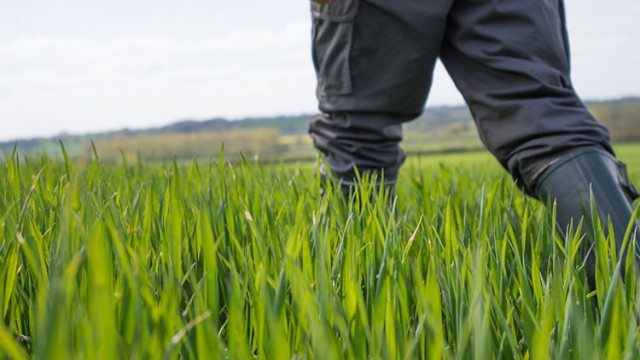 The number of people looking to buy farmland so they can manage it to improve biodiversity or generate carbon credits is on the rise, according to land and property specialists Strutt & Parker.
The number of people looking to buy farmland so they can manage it to improve biodiversity or generate carbon credits is on the rise, according to land and property specialists Strutt & Parker.
“One of the most notable developments in the marketplace over recent months has been increased demand from green investors looking at alternative land uses to food production,” said Matthew Sudlow, head of estates and farm agency.
“They still represent a very small subset of the market, but it does look as if that proportion is set to grow.
We now receive phone calls on almost a daily basis from buyers interested in purchasing land to be managed environmentally – with their plans involving tree planting, rewilding and other conservation and carbon-offset projects.
“Interestingly, such buyers are starting to become active in lowland areas of England, as well as the uplands,” he added.
“Growth in environmental land investment is a trend we are also seeing in Scotland and Wales.”
Role of non-farmers in buying farmland
Analysis of Strutt & Parker’s Farmland Database, which records the details of all farms, estates and blocks of publicly marketed farmland in England over 100ac in size, shows that while farmers remain the biggest buyers of farmland, non-farmers are playing an increasingly large role in the market.
The proportion of farms bought by farmers has dropped to 52%, which is its lowest level since Strutt & Parker’s survey started over 20 years ago. Whereas the proportion bought by lifestyle buyers and private investors has risen to its highest level – accounting for 47%.
Strutt & Parker’s data shows the volume of land coming onto the market remained at record low levels during the first three months of the year.
“Only 20 farms were publicly marketed in the first quarter of the year, which is below the five-year average of 24,” said Sudlow.
The farms were also smaller than in previous years and so the 4,600ac publicly marketed is well below the five-year average of 6,100ac.
“With demand also remaining relatively robust, this means prices have remained virtually unchanged at an average of £9,200/ac for arable land and £7,000/ac for pasture.
“However, prices continue to be very variable around these averages, depending on supply and demand within a localised area,” he concluded.
The post Green investment in farmland on the rise appeared first on Agriland.co.uk.
]]>The post Farmland supply was the lowest on record in Scotland during 2020 appeared first on Agriland.co.uk.
]]>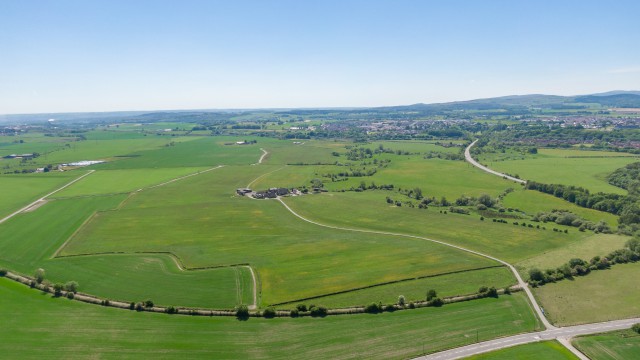 Demand for farmland in Scotland outstripped supply in 2020, due to a combination of low volumes, an increase in lifestyle buyers looking for smaller holdings and sustained interest in land suitable for tree planting, according to new research from land and property specialists Strutt and Parker.
Demand for farmland in Scotland outstripped supply in 2020, due to a combination of low volumes, an increase in lifestyle buyers looking for smaller holdings and sustained interest in land suitable for tree planting, according to new research from land and property specialists Strutt and Parker.
Analysis of data from the past 12 months shows the performance of the farmland market was atypical relative to recent years, in terms of both supply and demand.
Supply of farmland to the open market in 2020 was the lowest on record, with just 13,100ac advertised for sale, compared with a five-year average of 32,800ac.
Diane Fleming, farm agent for Strutt and Parker in Scotland, said:
“Spring 2020 brought us the unknown world of lockdown and travel restrictions and prospective sellers were also cautious to commit to selling faced with the additional uncertainties caused by Brexit and whether or not a trade deal with the EU would be agreed.
“Active buyers did not show the same restraint, competing vigorously for those farms available for sale, which saw demand quickly outstrip supply.”
Sales analysis
Strutt and Parker’s analysis shows that 82% of farms marketed successfully found a buyer by the end of the year, up 26% on 2019 (however, more farms were marketed in 2019 than in 2020).
In addition, there was also a rise in the number of off-market deals, where vendors chose not to commit to open market advertising, but were prepared to accommodate buyer interest on a private basis.
It is estimated that up to 30% of farms for sale during 2020 were available on a private basis.
In general, competitive bidding was witnessed at closing dates and values above the asking price were achieved, although variable values were seen across different regions and types of land.
Prime arable values remained particularly strong with the price of first-class arable land peaking at £16,000/ac due to a combination of low supply and high demand from successful agricultural businesses looking to expand.
Secondary arable values ranged from £3,000/ac to £6,000/ac, with grass leys achieving between £2,500/ac and £5,250/ac.
Overall, farmer buyers accounted for the majority of transactions during the year.
Forestry buyers
However, forestry buyers dominated when it came to hill ground. Strong prices continue to be paid for land suitable for forestry planting.
Plantable hill ground is attracting prices of up to £3,000/ac, with the price paid by forestry buyers for hill ground anywhere up to 30 times higher than it was a decade ago.
Less productive grassland and even marginal arable ground can also attract interest from these buyers.
Fleming said:
As seen in recent years, strong prices are continually paid for land with afforestation potential. Tree planting is backed by government support and afforestation commitments, in the quest to attain carbon neutrality.
“Private companies and investors are also keen to acquire forests, plant trees or purchase carbon credits to offset their carbon footprint.”
The post Farmland supply was the lowest on record in Scotland during 2020 appeared first on Agriland.co.uk.
]]>The post ‘Low supply and pent-up demand’ sees farmland values rise 3% in 2020 appeared first on Agriland.co.uk.
]]> Farmland values rose by an average of 3% in England during the first six months of 2020 because of historically low supply and pent-up demand, according to latest figures from land and property specialists Strutt & Parker.
Farmland values rose by an average of 3% in England during the first six months of 2020 because of historically low supply and pent-up demand, according to latest figures from land and property specialists Strutt & Parker.
Analysis of the Farmland Database, which records the details of all blocks of publicly marketed farmland over 100ac in size, shows the average price of arable land sold during the first six months of 2020 was £9,400/ac, up from a 2019 average of £9,100/ac.
Low supply and pent-up demand
“Although the market was effectively paused during the coronavirus lockdown period, low supply and pent-up demand have helped to push up average prices,” said Matthew Sudlow, head of estates and farm agency.
The market sentiment at the start of the year was one of optimism following an end to some of the political uncertainty that had been slowing the market. These figures suggest that despite an unsettling few months the appetite to buy land has not been diminished.
Sudlow further explained that not all vendors will have benefited from a rise because, while 40% of land sold for £10,000/ac or more, there was also a rise in the amount selling for less than £8,000/ac.
“Prices continue to show huge polarisation ranging from a high of £17,500/ac to a low of £5,200/ac, with significant regional variation in prices and the range of prices within regions.”
The 23,000ac publicly marketed during the first half of the year was one of the lowest figures on record. Lockdown measures meant supply dropped to 50% of 2019 levels in March, 25% in April and 15% in May. It rebounded in June, but the total volume of land launched this year is still 50% down on 2019 levels.
In total, 79 farms were publicly marketed during the first half of the year, compared with 136 in the equivalent period last year. Only two farms bigger than 1,000ac have been launched and only a handful of farms larger than 500ac.
Ever since the “pause button” was released on the market in mid-May activity from buyers has increased, said Sudlow.
We are seeing new people entering the market to register interest in farmland, particularly lifestyle buyers, and others returning to focus on their searches.
“In most regions, our agents are now busier than they were 12 months ago, albeit in a market where supply continues to be suppressed. Some buyers are cautious of a second lockdown later in the year and are therefore wishing to buy now.”
‘Slice of rural life’
Sudlow says it is difficult to make firm predictions about the coming months because there are still a number of uncertainties to be faced.
“We know there are some issues on the horizon which could result in some downside risk and even greater price volatility.
“Along with the inevitable global and national economic pressures as the year progresses, the UK is on the brink of implementing a new Agriculture Bill and Environment Bill and still needs to agree its post-Brexit trade deals, which could have a major impact on farm profitability.
Sudlow further went on to to say that, balanced against this, it is possible the market will “benefit from a rise in lifestyle buyers seeking a slice of rural life following their experiences of lockdown in a city”.
“Our agents are also fielding more inquiries from buyers interested in tree planting and implementing other environmental measures, hoping to lock into new income streams that are developing from the management and enhancement of natural capital.
“Our conversations with potential buyers also point to many seeing land as a safe asset class in which to invest at times of uncertainty – a trend we have seen in the past,” concluded Sudlow.
The post ‘Low supply and pent-up demand’ sees farmland values rise 3% in 2020 appeared first on Agriland.co.uk.
]]>The post Video: How to carry out grass measuring on your farm appeared first on Agriland.co.uk.
]]>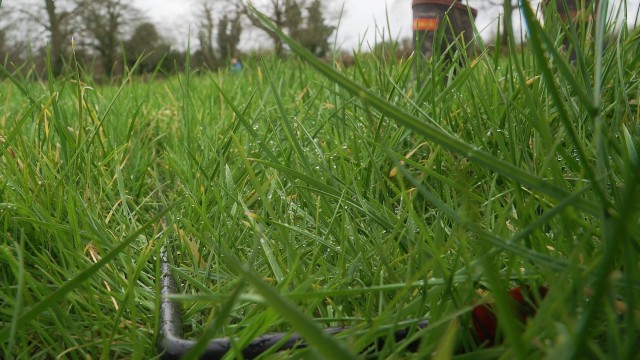 Grazed grass is the cheapest feed available to Irish farmers and is key to achieving high levels of performance in terms of liveweight gain and milk solids production.
Grazed grass is the cheapest feed available to Irish farmers and is key to achieving high levels of performance in terms of liveweight gain and milk solids production.
Maintaining a supply of high-quality grass on the farm can be achieved by walking the farm weekly and measuring the amount of grass on the farm.
Grass measuring brings numerous benefits, including: maximising pasture growth rates; extending the grazing season; maintaining and improving pasture growth rates; increasing the proportion of grazed grass in the diet; and reducing costs – just to name a few.
As the saying goes, ‘you can’t manage what you don’t measure’, so measuring grass allows the farmer to make more informed and effective grassland management decisions on the farm.
In last week’s episode of FarmLand, Walsh Fellow, Seán McMahon showed us just how easy it is to adopt this practice on your farm, while also noting the equipment needed to do so.
There are many methods out there used to measure grass – one option is the cut and weight method. Using this method, the farmer places a quadrant down onto a representative sample of grass in the paddock.
The grass should be cut down to 4cm using a shears. From here, the cut grass should be weighed, before using a simple calculation to find out what the cover of the paddock is.
Another popular method of measuring grass outlined by Seán is using a plate meter. With this method, the farmer will take a number of ‘drops’ or measurements throughout the paddock – sometimes in a W or an X pattern.
The farmer will then take the post-grazing height – or residual – from the average height of grass in the paddock; this figure should then be multiplied by 250kg of dry matter (DM), as there is 250kg of DM in a 1cm.
The post Video: How to carry out grass measuring on your farm appeared first on Agriland.co.uk.
]]>The post Video: Top tips when carrying out one of the most important jobs on a dairy farm appeared first on Agriland.co.uk.
]]>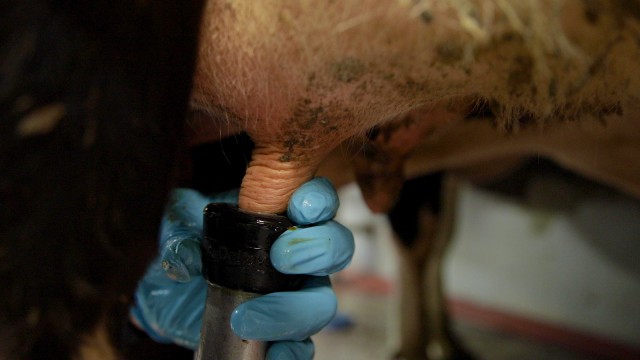 The milking routine is the most important job on a dairy farm, because you could say it is the only time you are really making money.
The milking routine is the most important job on a dairy farm, because you could say it is the only time you are really making money.
Therefore, it is critical that dairy farmers complete this process to the highest of standards.
The milking routine is also a very repetitive action and takes up a large proportion of a dairy farmer’s working day, so it can put enormous pressure and strain on dairy farmers.
In our most recent episode of FarmLand, Teagasc’s Padraig O’Connor gave some top tips on how farmers can cut down on time spent in the parlour, as well as making sure the farmer’s own health is maintained while carrying out this repetitive job.
One of the stand out points made by Padraig was the importance of switching hands when putting on and taking off the clusters. This will help farmers avoid shoulder and back pains.
He advised farmers to use their right hand if the cows are on the left-hand side of the parlour and use their left hand if they are on the right-hand side.
On being more efficient, Padraig gave advice on getting the parlour ready, getting yourself ready and ways farmers can save time during the milk process.
When putting on the clusters, Padraig stressed that the best place to start is at the front of the parlour.
He said this is important for two reasons: you can begin to start milking while the cows are still entering the parlour; and when taking the clusters off, you can teat spray the cows and begin to let them out while you finish cupping off.
The post Video: Top tips when carrying out one of the most important jobs on a dairy farm appeared first on Agriland.co.uk.
]]>The post A ‘no deal’ scenario: ‘The real fear is cheaper beef imports undermining our market’ appeared first on Agriland.co.uk.
]]>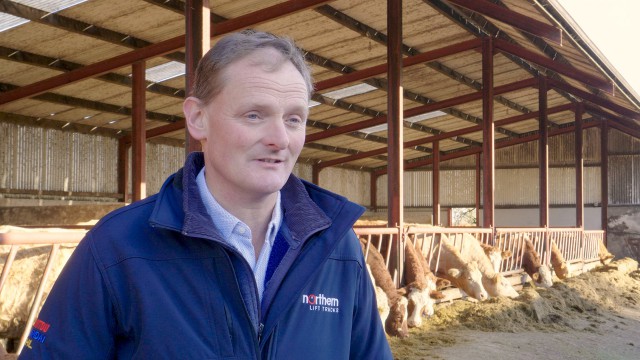 A no deal scenario would have serious implications for Irish and Northern Irish farmers across many enterprises and it has caused major concern.
A no deal scenario would have serious implications for Irish and Northern Irish farmers across many enterprises and it has caused major concern.
Last week, a draft proposal for the implementation of Brexit was published. The withdrawal agreement – which was recognised between Britain and the EU – was overwhelmingly welcomed by the Irish Government.
David Browne – the deputy president of the Ulster Farmers’ Union – also cautiously welcomes the agreement and outlined that a no deal outcome is a bad scenario for agriculture.
“It has been made very very clear right throughout the structure of the UFU that a no deal outcome would be a bad scenario for agriculture and the businesses that would struggle in that situation.”
The idea of a ‘hard border’ would have serious implications for farmers and business owners operating both north and south of the border.
While all sectors would be affected, Mr. Browne highlighted that the sheep export market would be severely impacted.
“The market that has been highlighted time and time again has been sheep businesses. At present, some 95% of sheep exports from the whole of the UK is into EU countries. If we were faced with the situation where we couldn’t access those markets – even in the short term – that would put businesses under incredible pressure.”
Continuing, he said: “50% of our sheep go south of the border along with 30% of our milk and pigs come north; it’s not until you dive down into those figures that you realise how much export dependent as a country and a nation we are.”
The deputy president also outlined the concerns of farmers on the ground surrounding Britain’s withdrawal.
“It would be foolish of me to say that when we take a position it’s going to be universally popular – that’s never going to be the case; not with the 11,500 farming families we represent.
“The views are that we can live with this, but we don’t want to face a scenario where we have no deal. Farmers were certainly expressing a lot of worry about facing the possibility of a no deal outcome, because – not alone the UFU – but all the four UK unions have been making it very clear that a no deal scenario would be the worst possible outcome.”
Mr. Browne finishes store lambs in conjunction with a suckler-to-beef enterprise. He highlighted that a no deal scenario could mean that beef would have to compete with lower-priced product from other countries outside of the EU.
“The whole of the UK is not self sufficient with beef and – at a first glance – you might think that that creates opportunity for Northern Ireland.
“However, when you actually ask the question, you discover that there are issues to do with carcass balance and the fifth quarter, so it’s not a straightforward answer.
“The real fear from the beef sector has been that – in a no deal scenario – we would face the likelihood of cheaper imports coming in and actually undermining our market.”
The post A ‘no deal’ scenario: ‘The real fear is cheaper beef imports undermining our market’ appeared first on Agriland.co.uk.
]]>The post Volunteers sought by RSPB NI for farmland surveys appeared first on Agriland.co.uk.
]]>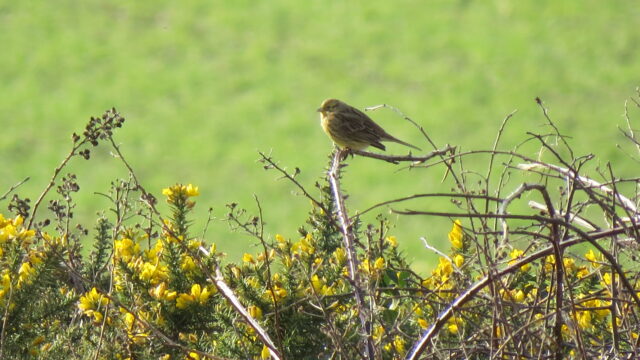 Do you have a love for nature and a fondness for birds, and can you tell a yellowhammer from a redshank and a skylark from a song thrush?
Do you have a love for nature and a fondness for birds, and can you tell a yellowhammer from a redshank and a skylark from a song thrush?
The Royal Society for the Protection of Birds, Northern Ireland, (RSPB NI) is seeking volunteers as farmland surveyors in east Co. Down, as part of its ‘Farming Together with Nature’ project.
In decline
Species such as yellowhammers, skylarks and linnets have experienced widespread decline in recent years, mainly due to a loss of seed-rich habitat.
However, east Co. Down is one of the last remaining strongholds for priority seed-eating species in the country.
RSPB NI is working with farmers in the county to provide ‘the big three’ for priority seed-eating birds.
“These are a summer insect source, a winter seed source and suitable nesting habitat. If one of these requirements is lost or depleted, these birds will find it difficult to survive, especially in winter when food is in short supply,” said a spokesperson.
“Luckily there are lots of simple things that farmers can do to help birds and other wildlife prosper on their land.”
Volunteers
Volunteer surveyors, he said, are absolutely essential in helping to deliver this project. All volunteers need is knowledge of identifying common farmland birds.
 Volunteering, the spokesperson said, provides an excellent opportunity to further improve bird identification skills, increase knowledge of farmland wildlife ecology, and learn more about farming.
Volunteering, the spokesperson said, provides an excellent opportunity to further improve bird identification skills, increase knowledge of farmland wildlife ecology, and learn more about farming.
Full training will be delivered in early March. “It is also a great way to get to see some beautiful parts of the countryside you may not have seen before,” said the spokesman.
Volunteer, Ron Price, conducts the surveys every year.
The rewards are spectacular, seeing and hearing birds including yellowhammers and reed buntings first thing in the morning. The farmer I was working with was very accommodating and it was a pleasure to survey his land. I would encourage as many people as possible to get involved.
The surveys take place in the early mornings between late April and June, and volunteers are asked to visit their designated farm four times over this period.
Visits take between three and five hours, depending on the size of the farm. When complete, farmers will receive a follow-up advisory visit to see how they can help the species found on their land.
Follow-up surveys will then be undertaken on a three-year basis to monitor any changes in wildlife populations.
With increasing pressures facing farmland wildlife, it is becoming more important for farmers and landowners to do what they can to help give nature a home, said the RSPB NI spokesperson.
“Advisory support from RSPB NI can help farmers make the most of their land, both for production and wildlife,” the spokesman added.
If you are an interested in becoming a volunteer farmland surveyor, contact RSPB NI volunteering development officer Colin Graham by emailing: [email protected].
The post Volunteers sought by RSPB NI for farmland surveys appeared first on Agriland.co.uk.
]]>The post Pics: Massive 2,000ac farm goes on the market in the UK for €29m appeared first on Agriland.co.uk.
]]>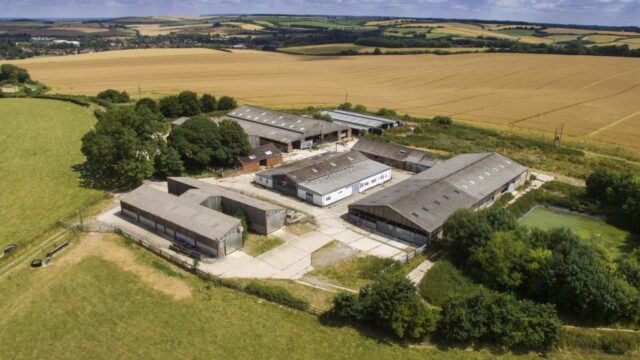 A large commercial farm located in the south of the England has been placed on the market and valued at £25m (€29.3m), by selling agents Savills.
A large commercial farm located in the south of the England has been placed on the market and valued at £25m (€29.3m), by selling agents Savills.
The Compton Estate has close to 2,000ac (809.ha) and is available to purchase as a whole or in lots.
The estate is located between the villages of East Isly and Compton, which is 100km away from the centre of London.
It consists of extensive modern farm buildings, 18 residential properties, offices and amenity property.
The Compton Estate is described as an attractive and substantial holding, set within the landscape of the North Wessex Downs Area of Outstanding Natural Beauty.
It is made up of predominantly arable farmland, with some blocks of mature woodland and pasture land also mixed in.
The first lot comprises of the largest amount of farmland and agricultural buildings, including a total of 889.57ac of farmland and a livestock shed capable of housing over 500 head of cattle.
The farmland is made up of 400ac of arable land, 205ac of pasture land, 185ac of restricted land and 64ac of woodland. The first lot also includes two farmsteads, Mayfield Farm and Cheseridge Farm.
The Mayfield Farmstead was constructed in 2004 as a state of the art dairy unit. The principal four span livestock building has housing for 560 head of cattle across ten rows of cubicles with access to the collecting area and herringbone milking parlour.
There are also a range of offices and general welfare facilities with viewing areas over the cubicles and milking parlour.
The farmstead also includes a calf unit, workshop and general storage barns suitable for agricultural machinery.
Other buildings in Mayfield Farmyard include several older stock buildings to the north of the yard which are now used for storage, silage clamps and a redundant grain dryer facility.
Meanwhile, on Cheseridge Farmstead is advertised as being in a more secluded area and is surrounded by pasture land and woodland.
The farmyard includes former livestock buildings which are extensive but currently redundant. There are also two sheds with a total of 280 cubicle spaces.
The old milking parlour is located centrally in the farmyard with offices and timber storage space on the side bays.
Cheseridge farmstead also includes a number of other larger barns used for the storage of agricultural machinery.
The post Pics: Massive 2,000ac farm goes on the market in the UK for €29m appeared first on Agriland.co.uk.
]]>The post New Zealand’s ‘largest farmer’ to sell off 10 farms totalling 11,650ha appeared first on Agriland.co.uk.
]]> State-owned farming business Landcorp is set to sell off 10 farms in New Zealand totalling close to 11,650ha over the next few months.
State-owned farming business Landcorp is set to sell off 10 farms in New Zealand totalling close to 11,650ha over the next few months.
Landcorp currently owns up to 140 farms across the country, with enterprises including beef, dairy, sheep and deer.
The business has made the decision to sell off 10 of its farms, which will be marketed over the next few months by PGG Wrightson Real Estate.
The listed properties are mainly sheep and beef units and they should attract an enthusiastic response from buyers, according to PGG Wrightson Real Estate General Manager, Peter Newbold.
In the regions where these properties are situated, there is a shortage of farms for sale of the quality and scale that these exhibit.
“As the country’s largest farmer, Landcorp has an excellent reputation, and these farms present favourably.
“We expect prospective buyers will be keen to inspect them, and anticipate they will attract solid offers,” he said.
Two of the properties, an extensive sheep and beef breeding property of 1,483ha and a 120ha cattle grazing block with development potential, will be placed on the market this month.
There a number of first rights of refusal arrangements in place on the further eight properties in the Landcorp portfolio.
Depending on the decisions with regards to the rights of refusal, any farms still available are expected to be placed on the open market in late January and early February 2017.
A 1,480ha Beef And Sheep Farm
One of the farms already on the market, Copper Road farm, is based in the Waitahuna region on the South Island, around 80km southwest of the city of Dunedin.
The farm is advertised as an extensively developed sheep and beef breeding property with exceptional infrastructure.
Included on the farm are three recently renovated homes, a large four-stand woolshed combined with covered yards complex, satellite sheep yards, steel cattle yards as well as supporting farm buildings.
The property also has its own private water scheme servicing 45 troughs to an area of approximately 400ha, which is then balanced by springs, creeks and well constructed dams.
Copper Road is subdivided into 112 paddocks with central lane systems and a very good standard of fencing.
The post New Zealand’s ‘largest farmer’ to sell off 10 farms totalling 11,650ha appeared first on Agriland.co.uk.
]]>The post Ever wanted to buy land in Poland? Well now you can’t appeared first on Agriland.co.uk.
]]>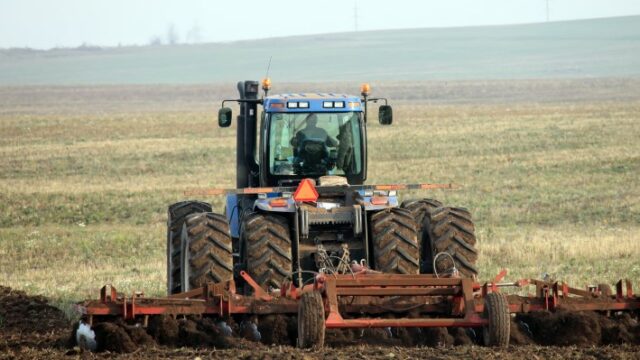 New Polish land laws have come into effect meaning that if you wanted to buy some agricultural land in the eastern European country you are no longer able to.
New Polish land laws have come into effect meaning that if you wanted to buy some agricultural land in the eastern European country you are no longer able to.
The legislation came into effect on May 1, 2016 after the Polish government passed it last year.
Under the Act, restrictions will apply on land purchases – such as making sure that the land is used for farming.
Furthermore, only people who have the relevant qualifications to be farmers can buy land and the size of each farm is limited to 300ha.
The land law also requires that prospective buyers have lived in a given locality in Poland for five years and pledge to work the land themselves that they buy for 10 years.
Any abuse of the law on this will result in land being acquired the Polish government’s department with responsibility for land and it will then be sold on at market value.
Another specification in the legislation says that existing owners of farmland cannot pass on the land to their son or daughter; unless it will continue to be used as farmland.
Upon joining the EU in 2004, a 12-year opt-out law was put in place which prevented non-Poles from buying rural land as the government was concerned that western Europeans would begin to buy large amounts of land.
This legislation was passed last year and comes into effect as that 12-year opt-out law became void on May 1.
However, it is understood that the European Commission is looking into the land law as it may be discriminatory to EU citizens, which is forbidden under law.
Similar land laws in Bulgaria, Hungary and Slovakia are being examined by the European Commission as they were considered to be discriminatory to EU nationals.
The post Ever wanted to buy land in Poland? Well now you can’t appeared first on Agriland.co.uk.
]]>The post See how much an acre of land cost last year in your province appeared first on Agriland.co.uk.
]]>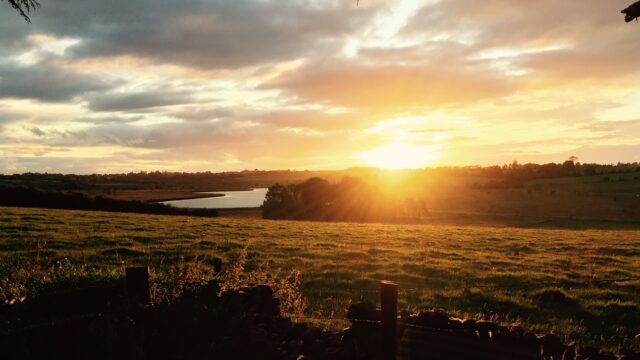 There’s been an 11% drop in the amount of money that was spent last year buying farmland on 2014 levels, the Ganly Walters Farm Market Survey for 2015 has found.
There’s been an 11% drop in the amount of money that was spent last year buying farmland on 2014 levels, the Ganly Walters Farm Market Survey for 2015 has found.
It estimates that more than €157m was spent buying more than 15,200ac of farmland last year.
This is an 11% drop from 2014 levels when it estimated that more than €177m was paid for 16,800ac.
However, the survey found that the average price for farmland nationwide in 2015 remained relatively constant at €10,336/ac, a decrease of only 1.8% from an average price of €10,526/ac in 2014.
The highest price achieved per acre during 2015 was for farms of 200ac or more with strong demand generating an average price of €12,630/ac.
This regional approach treats the commuter counties of Dublin, Kildare and Wicklow (DKW) as one region which is the market leader.
In the DKW, average prices per acre of farmland dropped again in 2015, down 9.4% after a 2.5% fall in 2014, Ganly Walters found.
Nevertheless, it has continued to be the most expensive area in Ireland at an average of €12,740/ac in 2015.
That is still 16.7% above the 2009 trough of €10,920 but 58% below the region’s peak of €30,543 seen in 2007, according to the survey.
Looking at the provinces, during 2015 there is very little to distinguish the average prices of farmland between Leinster and Munster, but a significantly higher number of properties were sold in Leinster than Munster.
Leinster
Leinster saw the most activity in 2015 with more than 22,500ac brought to the market in 310 lots and over 9,153ac sold in 135 transactions.
The average price paid per acre in the province was €10,603, compared with €11,102/ac in 2014.
Munster
In Munster over 153 lots with 12,700ac were brought to the market and 43 deals were done for 3,231ac.
The average price paid for farmland in this region in 2015 was €10,122/ac, compared to €10,713/ac in 2014.
Connacht
In Connacht over 5,100ac were on offer in 74 lots, of which 1,530ac sold in 27 deals. The average price in 2015 was €5,813.
Looking at the west and northwest including counties Donegal, Sligo, Leitrim, Mayo, Roscommon, Galway and Clare, farmland prices averaged €5,942/ac, down 10.3% on the €6,622/ac in 2014.
Ulster (Cavan, Monaghan and Donegal)
The three Ulster counties of Cavan, Monaghan and Donegal saw an average price for 2015 of €5,668/ac, achieved from 15 properties comprising 780ac and 5 transactions comprising more than 200ac.
The post See how much an acre of land cost last year in your province appeared first on Agriland.co.uk.
]]>The post Non-farmers are buying more land than farmers in the UK appeared first on Agriland.co.uk.
]]>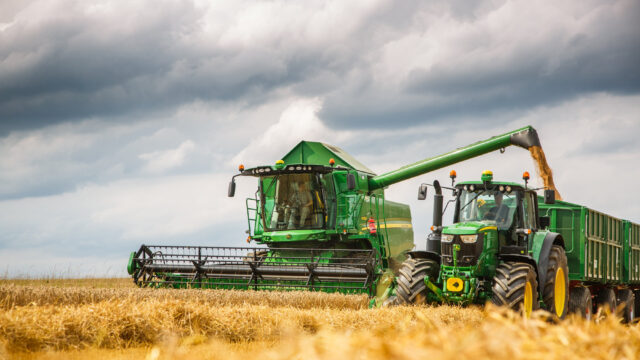 Non-farmer buyers have overtaken farmers as the main type of buyer of farmland in the UK, according to Savills.
Non-farmer buyers have overtaken farmers as the main type of buyer of farmland in the UK, according to Savills.
It says the proportion of farmers in the market has fallen slightly in the second quarter of the year due to weaker sentiment of some farmers due to lower current commodity prices.
Savills says farmer buyers in the UK are now at their lowest proportion since 2003.
However, according to Savills the proportion of buyers who are buying in order to expand continues to rise and now represents half of all buyers.
This indicates that many entrepreneurs are still growing their businesses, despite current commodity prices, reflecting the longer term view that they take.
It says medium-term (five year) forecasts for most agricultural commodities are positive in terms of demand and prices. It also reflects that many farms now produce significant nonfarming income which helps spread business risk.
In its latest report Savills says farms compete with other type of assets and investments for non-farmers’ money.
“Our research indicates that the proportion of ‘new’ non-farmer buyers also fell slightly, which reflects the recovery and greater economic and political certainty in other types of asset, such as residential, commercial and equities.
“Farmland is seen as a safe haven during a period of recession and, now that the recovery is firmly established, buyers will consider other assets more readily.
“However, those non-farmers who have already invested in farmland continue to do so, and are an increasing proportion of the market, reflecting that they like the tangibility of the asset and the returns it generates, which are not all financial,” it said.
Sellers
In the UK Farmer and non-farmer sellers each represent around 45% of all sellers with the remaining sellers being institutional or corporate.
According to Savills the reasons for selling also remain broadly similar to previous years, with business reasons, relocation and investment, being the main drivers.
“Our research indicates that there is an increased proportion of sellers citing retirement as the predominant reason to sell.
“Anecdotal evidence appears to confirm that some farmers, especially those without successors are taking the opportunity of current record values to exit the industry,” it said.
Savills have also found that debt related sales remain responsible for fewer than one in five sales but it expects this to be higher by the close of the year as commodity prices remain under pressure in the short term.
The post Non-farmers are buying more land than farmers in the UK appeared first on Agriland.co.uk.
]]>
